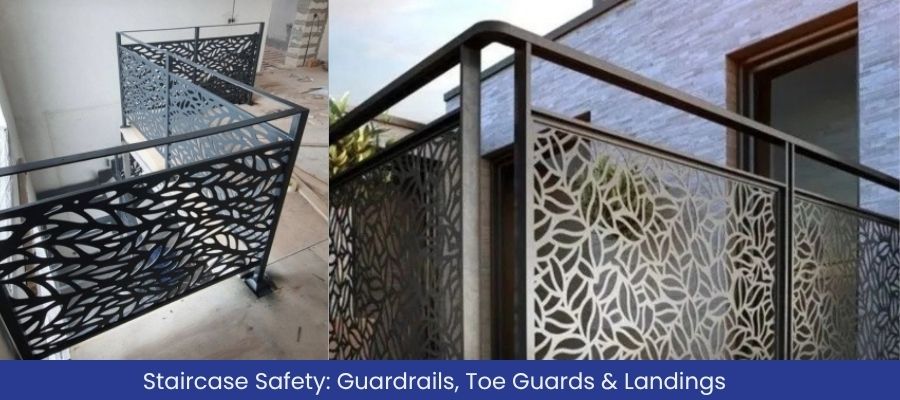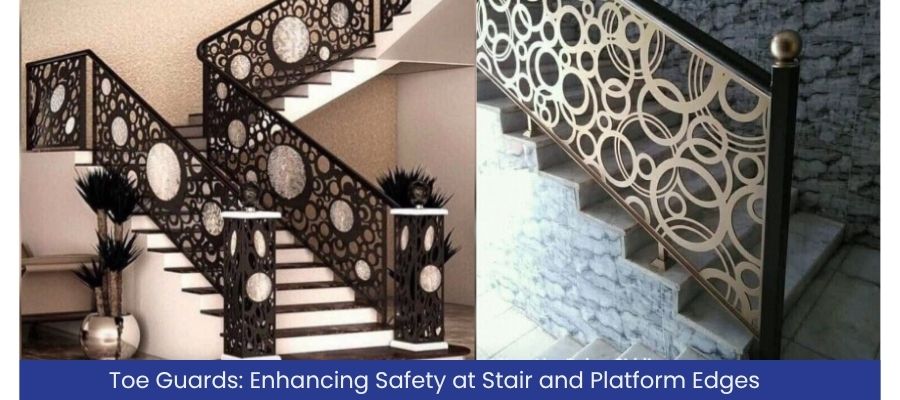The Role of Guardrails, Toe Guards and Landings in Staircase Safety Compliance

Objective
Explain the technical role of guardrails, toe guards and landings in staircase safety compliance. The article clarifies how these elements are defined, measured, designed and verified across different staircase types, including relevant, with emphasis on clear, actionable guidance that can be applied to residential and commercial contexts.
Introduction
Stair safety is not a decorative choice – it is a measurable, testable set of requirements. Whether the project involves a Spiral Staircase for Multi-Storey Building, a compact set of staircases in a duplex or an industrial run, compliance revolves around three critical elements: guardrails, toe guards and landings. Each element carries dimensional rules, performance criteria and interface conditions with treads and risers, doors, platforms and adjacent floors. This article explores how those pieces work together, what “compliant” typically means and how design intent translates into safe, verifiable assemblies in the field. We stay in the present tense and reference typical industry ranges to maintain evergreen applicability across jurisdictions.
Guardrails: Height, Openings and Load Resistance
A guardrail is required wherever the drop from the walking surface to the next lower level exceeds a threshold (commonly around 600 mm to 1,000 mm, may depend on rules). Typical height targets sit in the range from the leading-edge nosing line on stairs and on landings. Infill (balusters, panels, perforations, cables) controls openings so a small sphere does not pass through. Handrails are functionally separate from guardrails but may be integrated; the key distinction is that guardrails address edge protection while handrails address grasp requirements. Load criteria generally assume a concentrated line load at the top rail and an infill load (uniform) to ensure the assembly resists crowd forces without permanent deformation. Connections need verification at posts, stringers and slabs.

Toe Guards: Defining the Edge Condition
Toe guards, often called kick plates, run along the edge of a platform, landing or balcony to block wheels and loose items from rolling off. Typical heights are measured vertically from the walking surface. On stairs, toe guards may appear at the side of treads where open stringers meet an exposed edge or at intermediate platforms supporting carts or equipment. In warehouses and industrial settings, toe guards integrate with the guardrail post base plates and floor anchors. For residential stair runs with closed risers, toe guards may be implicit, but any exposed edge near a drop requires evaluation.
Landings: Geometry, Clearances and Flow
Landings are the reset points that allow users to stop, turn, pass or recover. A landing sits at the top and bottom of every stair flight and at designated intervals within long runs. Surface finishes must stay slip-resistant and uniform; abrupt level changes lead to trip points. Drainage at exterior landings needs attention so water does not pool at the nosing or doorway.
Applying These Rules to a Spiral Staircase
A spiral staircase is compact, but its geometry compresses tread width at the inner radius. Safety compliance focuses on: (1) minimum clear tread width measured at a defined radial distance from the central column, (2) consistent riser heights, (3) a continuous handrail and (4) an outer guardrail with compliant height and infill. Landings at entry and exit points provide a neutral platform before the user enters a rotating ascent or descent path. Toe guards may be required along the outer edge where objects could slip off between balusters. Visual contrast at nosings can help users perceive depth in the helical path.
Staircase Railings and Integration
A staircase railing pairs graspable profiles with a protective barrier. The handrail height commonly sits above nosings, coordinated with the top of the guardrail if they are combined. The termination must return to a wall or post to avoid catching clothing. Post spacing controls deflection; infill systems (bars, perforated metal, laminated panels) require documented opening limitations. At transitions – flight-to-landing, landing-to-balcony – the guardrail continues without gaps. Fixings into concrete, steel or timber substrates require anchors tested for tension and shear in the specified base material.
Residential Focus: Staircase Designs for Homes
In staircase designs for homes, small variations in rise or run cause disproportionate missteps. Residential compliance centers on riser uniformity, nosing projection and handrail continuity. Open rises (gaps between treads) may require a limit so a small sphere cannot pass through. Where a balcony overlooks a stairwell, guardrails maintain opening limits and height right to the edge. If the home includes a compact ss railing staircase, joints and welds at corners and posts need smooth finishes to avoid snag points. Landings at room thresholds prevent door leaves from swinging over treads.
Material Systems: Steel and Modular Approaches
Where steel staircases are specified, the guardrail posts and stringers may share the same steel framing system. Galvanization or appropriate coatings are selected to mitigate corrosion. Steel railings for staircase applications pair welded or bolted posts with infill panels tested for deflection under lateral load. For adaptable projects, Modular Staircases allow pre-engineered landings, stringers and guard packages that can be configured for different heights or footprints. Regardless of system, test certificates and installation records support compliance.
Structural Staircases and Load Paths
In structural staircases, guardrails are not an afterthought; they become part of the lateral-resisting detailing. Posts transfer loads to stringers, spines or landing beams; the top rail acts as a load collector. Stair vibration falls under serviceability criteria: comfortable response depends on stiffness and damping. Landing beams and fixings at the primary structure require shear and moment checks, especially when cantilevering a landing over an atrium. Documented calculations and as-built measurements keep the safety record clear.
Stair Cases: Treads, Risers and Nosing Control
For open stair cases, the baseline geometry stays consistent: riser heights uniform within a small tolerance, going depth consistent and nosing projection limited so feet do not catch on descent. Anti-slip nosing strips can be considered; however, the strip thickness must not create a lip. On landings, the surface transition to adjacent flooring remains flush. Stair width governs landing depth, handrail clearance from walls and passing capacity.
Guardrail Detailing: Infill and Edge Conditions
Infill options range from vertical bars to perforated sheets and laminated glass. Openings must not invite climbing (especially in residential contexts). Where children are present, horizontal rails may require changes or protective panels. At edges, terminate handrails cleanly with returns. At landings that interface with equipment, integrate toe guards into the base rail and protect fixings from impact. For exterior stairs, account for water shedding at the base of panels and avoid trapping debris against toe guards.
Toe Guards in Industrial and Mixed-Use Settings
Toe guards prevent wheel roll-off of carts and trolleys on mezzanines, platforms and landings. In mixed-use buildings, equipment moves across emergency routes, so a toe guard helps control object movement. At stair edges with open stringers, a low vertical plate or raised curb can serve the same function, provided it does not intrude on clear tread width. Where cleaning or drainage is critical, perforated toe plates may be used, but the perforation must not undermine the vertical barrier function.
Landings at Doors, Turns and Intersections
At doors, the landing must be deep enough that the door swing does not push over a step. For turning stairs (quarter- or half-landing), the landing platform provides the change in direction with uniform level surface. In long flights, intermediate landings break the run to meet maximum riser counts. For a Steel Staircases fleeding into a corridor, the landing ensures users step onto a level surface before navigating the hallway. Handrails continue across the landing if the fall risk persists.
Inspection, Testing and Documentation
Compliance is only defensible when documented. Measure guardrail heights from nosing lines along the stair pitch line; confirm infill opening limits with a test sphere; apply lateral load tests (as specified by local requirements) to handrails and guards; verify toe guard height; confirm landing dimensions and headroom. Record anchor types, torque values and substrate conditions. Maintain an inspection schedule: initial installation check, post-occupancy review and periodic re-checks – especially where large crowds or equipment use the stairs.
Conclusion
Staircase safety compliance is a system, not a single dimension. Guardrails manage edge exposure, toe guards control object roll-off and landings preserve circulation and reset visual rhythm. Whether the project specifies a compact Steel Staircases or large-format steel staircases, the same rules apply: define the geometry, control the edges, verify the loads and document the results. When each element is designed and installed with measurable criteria, the assembly performs as intended across homes, public buildings and industrial contexts.
FAQs About SS railing staircase
A guardrail is required along any open edge where a fall is possible, including stair flights, landings, balconies and platforms. Height and opening limits follow local regulations; typical heights range around on stairs and on landings.
A handrail is for grasping and guidance; a guardrail protects against falls at edges. They can be integrated, but they serve different functions and have different dimensional requirements.
Toe guards usually measure in height. The exact value may vary based on use type and local rules, but it must be continuous and fixed to stop wheels and small objects from rolling off edges.
Yes. Spiral stairs benefit from level landings at entry and exit points for safe transition. Landing depth must accommodate turning and door swings where applicable.
Typical records include drawings with dimensions, load calculations, material and anchor specifications, site measurements, load test reports and final inspection checklists.

Founder & CEO
Mukesh Patel is the Founder & CEO of Build Matt ltd, specializing in Pre-Engineered Buildings (PEB) and general steel fabrication. With advanced technology, modern machinery, and a skilled workforce, he delivers efficient and high-quality solutions across East and Central Africa, including Uganda, Kenya, Tanzania, Congo, South Sudan, Rwanda, and Burundi.
- CNC Plasma Cut Decorative Metal Panels: Revolutionizing Interior and Exterior Design
- Combining Roof Vents and Translucent Sheets for Better Airflow and Natural Lighting in Uganda Cities
- Top Design Trends in Steel Staircases for Modern Ugandan Buildings
- Steel Railings & Balustrades for Uganda Cities
- Modern Steel Silos & Hoppers : Transforming Grain Storage Efficiency in Uganda






